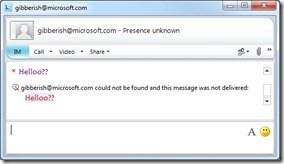Some of Lync’s Client-side error messages don’t really explain the reason for the failure. Here are a few and what they might be indicating. I hope they make your life a little easier:
Instant Messages
“<username> could not be found and this message was not delivered”
1) There is no such user at the recipient’s domain. There’s an instance of OCS/Lync there, they have an Edge, but you’ve simply nominated an invalid user – or guessed their e-mail naming format wrong.
2) There *is* such a user at the recipient’s domain – but they’re not enabled for Federation. There’s an instance of OCS/Lync there & they have an Edge. [TBC]
3) There *may be* such a user at the recipient’s domain – but they don’t have open Federation and THEY don’t trust YOUR domain. [In this example, my lab domain is not Federated with Microsoft].
Continue reading ‘Decoding Lync’s Client-Side Error Messages’ »
